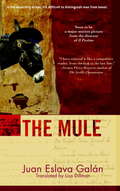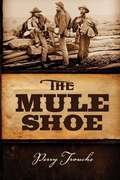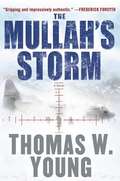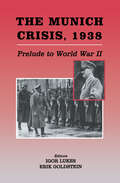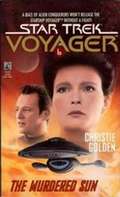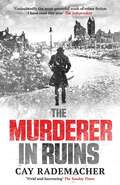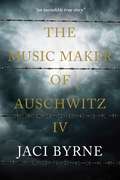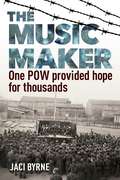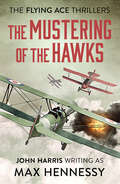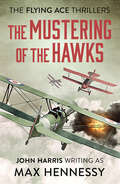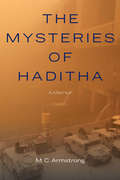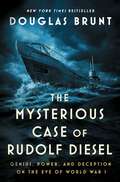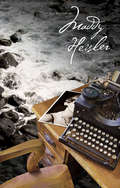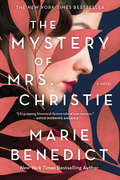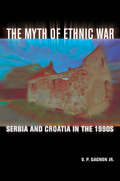- Table View
- List View
The Mule
by Juan Eslava GalanCritically acclaimed throughout Spain, and now available for the first time in English, this tender, satirical novel vividly captures the intrinsic absurdity of war--and the joys of true friendship in a place where it is difficult to distinguish man from beast.Juan Castro Pérez is a simple muleteer caught in the brutal Spanish Civil War. Never far from his closest companion--a stray mule named Valentina whom he is determined to keep for himself after the war--Juan engages in the low-brow drinking escapades, long shots at love, and an otherwise droning existence shared by his compatriots.As he lies, cheats, and steals to protect Valentina during his improbable odyssey home, Juan unwittingly "fights" for both sides--and becomes a reluctant and unlikely hero of the people, exploited by opportunistic journalists desperately trying to convince the Spanish public that the war is under control, when it is anything but.... Translation by Lisa Dillman.
The Mule Shoe
by Perry TroucheA TIME MACHINE COULD TAKE US NO CLOSER! Synopsis of The Mule Shoe by Perry Trouche Give a nearsighted child glasses for the first time and what you'll hear immediately is "I can see the leaves". This sudden clarity strikes the protagonist Conner DuMont in the final chapter of The Mule Shoe but it comes with a price. The dogma, promises and tradition of the past are gone. He can no longer go on doing things the way they have always been done. With this change comes awareness of his conformity and acquiescence to a society built on evil. The Mule Shoe is Conner's journey through his subconscious that takes him, past and present, through beliefs and memories to final acceptance of a new era built on truth. The trauma of the horror of combat hastens the process. Like the peeling of an onion causing tears, Conner's gradual descent into his mind unleashes emotions that overwhelm reality. The story is set at the battle of Spotsylvania, Virginia, in 1864 during the American Civil War, but Conner's mental journey encompasses his childhood on the sea islands of South Carolina, the recent death of his cousin for which he blames himself, and the fantasy of life through the eyes of the common soldiers he meets. He struggles to stay in the present but death, and the fear surrounding it, propel him into a dream world of memories, real and imagined. His day to day reality is increasingly bombarded with hallucinations in which the significant people of his past and present deliver a running commentary on his life. As the combat worsens at the Muleshoe Salient, he is unable to differentiate reality from delusion. He creates a world of calming touch to replace the insanity of war, readily embracing the delusion of soothing affection to overcome mind numbing savagery. The final acts of killing sever his last tie to his prior life. He retreats physically from battle as he wanders mentally in search of acceptance and peace. As he has learned to kill in reality, he finds he must do the same in his delusional world. The power to kill is the evil on which his world has been built. The final act of killing a childhood friend is so repugnant that it frees him from all attachment to his past. He accepts peace as he would use clear, cold water to rinse an open wound. Hope for life and peace replaces the misery of war. The Mule Shoe is twenty-four chapters, half of which are in the present, June 1864, and half, flashbacks and fantasy. The historical accuracy has been well researched and the emotional journey based on the author's extensive experience as a psychiatrist.
The Mullah's Storm
by Tom YoungA transport plane carrying a high-ranking Taliban prisoner is shot down in a blizzard over Afghanistan's mountainous Hindu Kush. The storm makes rescue impossible, and for two people-navigator Michael Parson and a female Army interpreter, Sergeant Gold-a battle for survival begins against not only the hazards of nature, but the treacheries of man: the Taliban stalking them, the villagers whose loyalties are unknown, and a prisoner who would very much like the three of them to be caught.
The Munich Crisis, 1938: Prelude to World War II
by Erik Goldstein Igor LukesMost of the works on the crises of the 1930s and especially the Munich Agreement in 1938 were written when it was virtually impossible to gain access to the relevant archive collections on both sides of the Iron Curtain. This text studies the Czechoslovak-German crisis and its impact from previously neglected perspectives and celebrates the post-Cold War openness by bringing in new evidence from hitherto inaccessible archives.
The Murder Trial of Judge Peel
by Jim BishopOriginally published in 1962, this is the true story account of one of Florida’s most chilling crimes.Joseph Peel, a crooked municipal judge of Palm Beach, Florida, is accused of killing fellow judge, Curtis Chillingworth, of the superior court, who mysteriously disappeared along with his wife, Marjorie Chillingworth, from their home in 1955.Peel was publicly reprimanded by Chillingworth in 1953, when Peel represented both sides in a divorce. In June 1955, Peel was scheduled to appear in court to answer charges of unethical conduct in yet another divorce case, and so faced disbarment.Since Peel was also using his position as an elected municipal judge to protect bolita operators and moonshiners by giving them advance warnings of raids in return for financial consideration, Peel faced the loss of his superior position—and thus his lucrative illegal racket…A gripping read.“Bishop’s reconstruction is well-ordered and well-observed, a stunning form of journalistic jazz, cool, crisp and all on one note, like a headline. […] A simple, speedy, thoroughly satisfying thriller…”—Kirkus Review
The Murdered Sun (Star Trek: Voyager #6)
by Christie GoldenWhen sensors indicate a possible wormhole nearby, Captain Janeway is eager to investigate, hoping to find a shortcut back to Federation space. Instead, she discovers a star system being systematically pillaged by the warlike Akerians. Janeway has no desire to get caught up in someone else's war, but in order to the check on the possibilities offered by the wormhole -- and to save the innocent people of Veruna Four -- VoyagerTM has no choice but to challenge the Akerians.
The Murderer in Ruins (Frank Stave Investigations #1)
by Cay RademacherSHORTLISTED FOR THE CWA INTERNATIONAL DAGGER AWARD 2016'Undoubtedly the most powerful work of crime fiction I have read this year' Independent'Vivid and harrowing' Sunday Times'Police procedural, romance, thriller The Murderer in Ruins has a bit of everything and it's one hell of a read.' BücherHamburg, 1947A ruined city occupied by the British, who bombed it, experiencing the coldest winter in living memory. Food and supplies are rationed; refugees and the homeless are crammed into concrete bunkers and ramshackle huts; trade on the black market is rife. A killer is on the loose, and all attempts to find him or her have failed. Plagued with worry about his missing son, Frank Stave is a career policeman with a tragedy in his past that is driving his determination to find the killer. With frustration and anger mounting in an already tense city, Stave is under increasing pressure to find out why - in the wake of a wave of atrocity, the grim Nazi past and the bleak attempts by his German countrymen to recreate a country from the apocalypse - someone still has the stomach for murder. The first of a trilogy, The Murderer in Ruins vividly describes a poignant moment in British-German history, with a riveting plot that culminates in a shocking denouement.Translated from ther German by Peter Millar
The Music Maker of Auschwitz IV
by Jaci ByrneThe inspirational true story of an Allied POW appointed Kapellmeister to the Nazis in Auschwitz. When called up to fight in yet another World War, Drum Major Jackson promised his beloved wife Mabel that he would return to lead his band and play for her once more. In May 1940, he was captured at Dunkirk and interned in several German forced labour camps throughout Poland. Two years later he was transferred to Auschwitz IV, part of the notorious concentration camp complex where it is not widely known held Allied POWs. When his captors appointed Jackson their &‘Kapellmeister&’ (man in charge of music), he seized the opportunity to provide entertainment for his fellow prisoners at rehearsals, and cover for escapees during concerts. Finally liberated in May 1945, malnourished and gravely ill, Jackson carried his secret war diary—an incredible exposé on five years of life and death in Nazi concentration camps. THE MUSIC MAKER OF AUSCHWITZ IV, based on Jackson&’s diary, is written by his granddaughter. It is a thrilling testament to the resilience one man found in the darkest of times through his two greatest loves—music and the woman who waited for him.
The Music Maker: One POW Provided Hope for Thousands
by Jaci ByrneOn May 8 1945, forty-six-year-old Drum Major Jackson staggered towards his American liberators. Emaciated, dressed in rags, his decayed boots held together with string, he’d been force-marched for twenty days over the Austrian Alps after five heinous years as a POW in Nazi labour camps. He collapsed into his liberators’ arms, clinging to his only meaningful possession—his war diary. Having already experienced the horrific nature of battle in the First World War, Jackson had now survived another War—unlike hundreds of his mates, who’d succumbed to disease, insanity, or had been killed in action. Men far younger than he. But he could never have imagined what awaited him on the home front. A captivating testament to human endurance, Jackson’s diary and photos, one of the last such memoirs to be published, is the inspiration for The Music Maker. An unforgettable and gripping true story about the life and times.
The Mustering of the Hawks (Flying Ace Thrillers)
by Max HennessyIn the skies over France, only the hawks survived.1917. The average life-expectancy of an RAF pilot on the Western Front is three weeks. Inexperienced young men are hurled into vicious dogfights over the trenches, often without adequate training, and are slaughtered by the German aces.Into this hell arrives Ira Penaluna, only nineteen years old and totally in love with aviation.As those who have become his friends die one-by-one, Ira realises that in a world where skill, speed and killer-instinct are all, there is only one way to survive: to think like a hawk.A searing, moving novel of the First World War, full to the brim with detailed historical research, perfect for fans of Thomas Wood and Wilbur Smith.
The Mustering of the Hawks (The Flying Ace Thrillers)
by Max HennessyIn the skies over France, only the hawks survived. First in the World War I historical thriller series from the author of The Mercenaries. 1917. The average life-expectancy of an RAF pilot on the Western Front is three weeks. Inexperienced young men are hurled into vicious dogfights over the trenches, often without adequate training, and are slaughtered by the German aces. Into this hell arrives Ira Penaluna, only nineteen years old and totally in love with aviation. As those who have become his friends die one by one, Ira realizes that in a world where skill, speed and killer-instinct are all, there is only one way to survive: to think like a hawk. A searing, moving novel of the First World War, full to the brim with detailed historical research, perfect for fans of Thomas Wood and Wilbur Smith.
The Myriad Legacies of 1917: A Year Of War And Revolution
by Maartje Abbenhuis Neill Atkinson Kingsley Baird Gail RomanoThis book explores the ramifications of 1917, arguing that it was a cataclysmic year in world history. In this volume, thirteen scholars reflect on the myriad legacies of the year 1917 as a year of war, revolution, upheaval and change. Crisscrossing the globe and drawing on a range of disciplinary approaches, from military, social and economic history to museum, memory and cultural studies, the collection highlights how the First World War remains ‘living history’. With contributions on the Russian revolutions, the entry of the United States into the war, the Caucasus and Flanders war fronts, as well as on India and New Zealand, and chapters by pre-eminent First World War academics, including Jay Winter, Annette Becker, and Michael Neiberg, the collection engages all with an interest in the era and in the history and commemoration of war.
The Mysteries of Haditha: A Memoir
by M. C. ArmstrongM. C. Armstrong secured his embed as a journalist with the Navy SEALs in 2008. Shortly before he left for Iraq his father asked him to tell the story no one else seemed to be telling, the story of the people sometimes constructed as our friends and other times our enemies: the Iraqis. &“But what about them?&” he asked. &“Who&’s their good guy? Who&’s their George Washington? That&’s the story you want to find. Talk to them.&” Armstrong&’s searing memories about his relationship with his father, his fiancé, and his SEAL team companion take the reader on a nosedive ride from a historically black college in the American South straight into Baghdad, the burn pits, and the desert beyond the mysterious Haditha dam. Culminating in the disclosure of a devastating secret, The Mysteries of Haditha explores the lengths Armstrong was willing to go to prove himself and to witness a truth he couldn&’t have prepared himself to receive. At once daring, dark, and hilarious, this memoir of M. C. Armstrong&’s journey pulls no punches and lifts the veil on the lies we tell each other and the ones we tell ourselves. The Mysteries of Haditha is a coming-of-age story and an unprecedented glimpse into the heart of the war on terror.
The Mysterious Case of Rudolf Diesel: Genius, Power, and Deception on the Eve of World War I
by Douglas BruntThis instant New York Times bestselling &“dynamic detective story&” (The New York Times) reveals the hidden history Rudolf Diesel, one of the world&’s greatest inventors, and his mysterious disappearance on the eve of World War I.September 29, 1913: the steamship Dresden is halfway between Belgium and England. On board is one of the most famous men in the world, Rudolf Diesel, whose new internal combustion engine is on the verge of revolutionizing global industry forever. But Diesel never arrives at his destination. He vanishes during the night and headlines around the world wonder if it was an accident, suicide, or murder. After rising from an impoverished European childhood, Diesel had become a multi-millionaire with his powerful engine that does not require expensive petroleum-based fuel. In doing so, he became not only an international celebrity but also the enemy of two extremely powerful men: Kaiser Wilhelm II of Germany and John D. Rockefeller, the founder of Standard Oil and the richest man in the world. The Kaiser wanted the engine to power a fleet of submarines that would finally allow him to challenge Great Britain&’s Royal Navy. But Diesel had intended for his engine to be used for the betterment of the world. Now, New York Times bestselling author Douglas Brunt reopens the case and provides an &“absolutely riveting&” (Chris Bohjalian, #1 New York Times bestselling author) new conclusion about Diesel&’s fate. Brunt&’s book is &“equal parts Walter Isaacson and Sherlock Holmes, [and] yanks back the curtain on the greatest caper of the 20th century in this riveting history&” (Jay Winik, New York Times bestselling author).
The Mystery of Courage
by William Ian MillerFew of us spend much time thinking about courage, but we know it when we see it--or do we? Is it best displayed by marching into danger, making the charge, or by resisting, enduring without complaint? Is it physical or moral, or both? Is it fearless, or does it involve subduing fear? Abner Small, a Civil War soldier, was puzzled by what he called the "mystery of bravery"; to him, courage and cowardice seemed strangely divorced from character and will. It is this mystery, just as puzzling in our day, that William Ian Miller unravels in this engrossing meditation. Miller culls sources as varied as soldiers' memoirs, heroic and romantic literature, and philosophical discussions to get to the heart of courage--and to expose its role in generating the central anxieties of masculinity and manhood. He probes the link between courage and fear, and explores the connection between bravery and seemingly related states: rashness, stubbornness, madness, cruelty, fury; pride and fear of disgrace; and the authority and experience that minimize fear. By turns witty and moving, inquisitive and critical, his inquiry takes us from ancient Greece to medieval Europe, to the American Civil War, to the Great War and Vietnam, with sidetrips to the schoolyard, the bedroom, and the restaurant. Whether consulting Aristotle or private soldiers, Miller elicits consistently compelling insights into a condition as endlessly interesting as it is elusive.
The Mystery of Maddy Heisler
by Daniel LillfordAs a young man in the midst of World War II, Jacob fell in love with an older woman and began a rapturous affair, until she seemingly vanished. As strange things start to happen around him, a familiar young woman appears at Jacob's house with a mysterious notebook. The past doesn't stay buried and the mystery of Maddy Heisler is reveled. With secrets and lies, lovers and spies, Jacob will never be the same again.
The Mystery of Mrs. Christie: A Novel
by Marie Benedict"A deft, fascinating page-turner replete with richly drawn characters and plot twists that would stump Hercule Poirot." —Kate Quinn, New York Times bestselling author of The Alice Network, The Huntress, and The Rose CodeThe New York Times and USA Today bestselling author of The Only Woman in the Room returns with a thrilling reconstruction of one of the most notorious events in literary history: Agatha Christie's mysterious 11-day disappearance in 1926.In December 1926, Agatha Christie goes missing. Investigators find her empty car on the edge of a deep, gloomy pond, the only clues some tire tracks nearby and a fur coat left in the car — strange for a frigid night. Her World War I veteran husband and her daughter have no knowledge of her whereabouts, and England unleashes an unprecedented manhunt to find the up-and-coming mystery author. Eleven days later, she reappears, just as mysteriously as she disappeared, claiming amnesia and providing no explanations for her time away. The puzzle of those missing eleven days has persisted. With her trademark historical fiction exploration into the shadows of the past, acclaimed author Marie Benedict brings us into the world of Agatha Christie, imagining why such a brilliant woman would find herself at the center of such murky historical mysteries. What is real, and what is mystery? What role did her unfaithful husband play, and what was he not telling investigators? Agatha Christie novels have withstood the test of time, due in no small part to Christie's masterful storytelling and clever mind that may never be matched, but Agatha Christie's untold history offers perhaps her greatest mystery of all. Fans of The Secrets We Kept, The Lions of Fifth Avenue, and The Alice Network will enjoy this riveting saga of literary history, suspense, and love gone wrong. Also By Marie Benedict: The Other Einstein Carnegie's Maid The Only Woman in the Room Lady Clementine
The Myth Of Ethnic War: Serbia and Croatia in the 1990s
by V. P. Gagnon Jr."The wars in Bosnia-Herzegovina and in neighboring Croatia and Kosovo grabbed the attention of the western world not only because of their ferocity and their geographic location, but also because of their timing. This violence erupted at the exact moment when the cold war confrontation was drawing to a close, when westerners were claiming their liberal values as triumphant, in a country that had only a few years earlier been seen as very well placed to join the west. In trying to account for this outburst, most western journalists, academics, and policymakers have resorted to the language of the premodern: tribalism, ethnic hatreds, cultural inadequacy, irrationality; in short, the Balkans as the antithesis of the modern west. Yet one of the most striking aspects of the wars in Yugoslavia is the extent to which the images purveyed in the western press and in much of the academic literature are so at odds with evidence from on the ground."—from The Myth of Ethnic War V. P. Gagnon Jr. believes that the Yugoslav wars of the 1990s were reactionary moves designed to thwart populations that were threatening the existing structures of political and economic power. He begins with facts at odds with the essentialist view of ethnic identity, such as high intermarriage rates and the very high percentage of draft-resisters. These statistics do not comport comfortably with the notion that these wars were the result of ancient blood hatreds or of nationalist leaders using ethnicity to mobilize people into conflict. Yugoslavia in the late 1980s was, in Gagnon's view, on the verge of large-scale sociopolitical and economic change. He shows that political and economic elites in Belgrade and Zagreb first created and then manipulated violent conflict along ethnic lines as a way to short-circuit the dynamics of political change. This strategy of violence was thus a means for these threatened elites to demobilize the population. Gagnon's noteworthy and rather controversial argument provides us with a substantially new way of understanding the politics of ethnicity.
The Myth of Inevitable US Defeat in Vietnam (Strategy and History)
by Dale WaltonThis book offers a dispassionate strategic examination of the Vietnam conflict that challenges the conventional wisdom that South Vietnam could not survive as an independent non-communist entity over the long term regardless of how the United States conducted its military- political effort in Indochina.
The Myth of Martyrdom: What Really Drives Suicide Bombers, Rampage Shooters, and Other Self-Destructive Killers
by Adam LankfordThe Myth of Martyrdom presents a startling look at the deepest, darkest secrets that terrorists pray you'll never know.For decades, experts from the most powerful governments and prestigious universities around the world have told us that suicide bombers are psychologically normal men and women driven by a single-minded purpose: self-sacrifice. As it turns out, this claim originated with the terrorist leaders themselves, who insisted that they would never recruit mentally unstable people to carry out suicide attacks. As these strikes have become both increasingly common and increasingly deadly, no one has challenged this conventional wisdom. These are fearless ideological warriors, we're told, who have the same resolve and commitment to their beliefs as our own Navy SEALs, because they're willing to die for the sake of their cause.In The Myth of Martyrdom, Adam Lankford argues that these so-called experts have it all wrong. The truth is that most suicide terrorists are like any other suicidal person—longing to escape from unbearable pain, be it depression, anxiety, marital strife, or professional failure. Their "martyrdom" is essentially a cover for an underlying death wish. Drawing on an array of primary sources, including suicide notes, love letters, diary entries, and martyrdom videos, Lankford reveals the important parallels that exist between suicide bombers, airplane hijackers, cult members, and rampage shooters. The result is an astonishing account of rage and shame that will transform the way we think of terrorism forever.We can't hope to stop these deadly attacks, Lankford argues, until we understand what's really behind them. This timely and provocative book flips a decades-old argument on its head—and has huge implications for our future.
The Myth of the Great War: A New Military History of World War I
by John MosierBased on previously unused French and German sources, this challenging and controversial new analysis of the war on the Western front from 1914 to 1918 reveals how and why the Germans won the major battles with one-half to one-third fewer casualties than the Allies, and how American troops in 1918 saved the Allies from defeat and a negotiated peace with the Germans.
The Myth of the Nuclear Revolution: Power Politics in the Atomic Age (Cornell Studies in Security Affairs)
by Keir A. Lieber Daryl G. PressLeading analysts have predicted for decades that nuclear weapons would help pacify international politics. The core notion is that countries protected by these fearsome weapons can stop competing so intensely with their adversaries: they can end their arms races, scale back their alliances, and stop jockeying for strategic territory. But rarely have theory and practice been so opposed. Why do international relations in the nuclear age remain so competitive? Indeed, why are today's major geopolitical rivalries intensifying?In The Myth of the Nuclear Revolution, Keir A. Lieber and Daryl G. Press tackle the central puzzle of the nuclear age: the persistence of intense geopolitical competition in the shadow of nuclear weapons. They explain why the Cold War superpowers raced so feverishly against each other; why the creation of "mutual assured destruction" does not ensure peace; and why the rapid technological changes of the 21st century will weaken deterrence in critical hotspots around the world.By explaining how the nuclear revolution falls short, Lieber and Press discover answers to the most pressing questions about deterrence in the coming decades: how much capability is required for a reliable nuclear deterrent, how conventional conflicts may become nuclear wars, and how great care is required now to prevent new technology from ushering in an age of nuclear instability.
The NVA and Viet Cong
by Kenneth Conboy Simon MccouaigIn 1940 Japan placed Vietnam under military occupation, restricting the local French administration to a figurehead authority. Seizing the opportunity, the Communists organised a Vietnamese independence league, the Viet Minh, whose armed forces became known as the PAVN (more commonly known to the West as the Vietcong, or NVA) and prepared to launch an uprising against the French at the war's end. This text details the history, organisation and uniforms of the People's Army of Vietnam from its origins in the fight against colonialism, through two separate wars against the US and Khmer Rouge, to its role in the modern era.
The Name of War: King Philip's War and the Origins of American Identity
by Jill LeporeWinner of the the 1998 Ralph Waldo Emerson Award of the Phi Beta Kappa Society King Philip's War, the excruciating racial war--colonists against Indians--that erupted in New England in 1675, was, in proportion to population, the bloodiest in American history. Some even argued that the massacres and outrages on both sides were too horrific to "deserve the name of a war." It all began when Philip (called Metacom by his own people), the leader of the Wampanoag Indians, led attacks against English towns in the colony of Plymouth. The war spread quickly, pitting a loose confederation of southeastern Algonquians against a coalition of English colonists. While it raged, colonial armies pursued enemy Indians through the swamps and woods of New England, and Indians attacked English farms and towns from Narragansett Bay to the Connecticut River Valley. Both sides, in fact, had pursued the war seemingly without restraint, killing women and children, torturing captives, and mutilating the dead. The fighting ended after Philip was shot, quartered, and beheaded in August 1676. The war's brutality compelled the colonists to defend themselves against accusations that they had become savages. But Jill Lepore makes clear that it was after the war--and because of it--that the boundaries between cultures, hitherto blurred, turned into rigid ones. King Philip's War became one of the most written-about wars in our history, and Lepore argues that the words strengthened and hardened feelings that, in turn, strengthened and hardened the enmity between Indians and Anglos. She shows how, as late as the nineteenth century, memories of the war were instrumental in justifying Indian removals--and how in our own century that same war has inspired Indian attempts to preserve "Indianness" as fiercely as the early settlers once struggled to preserve their Englishness. Telling the story of what may have been the bitterest of American conflicts, and its reverberations over the centuries, Lepore has enabled us to see how the ways in which we remember past events are as important in their effect on our history as were the events themselves.
